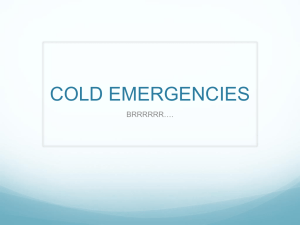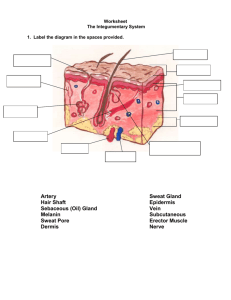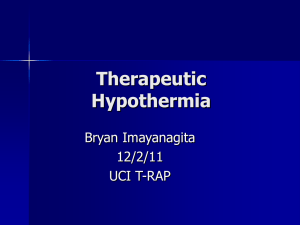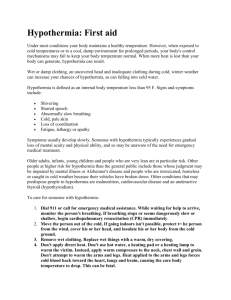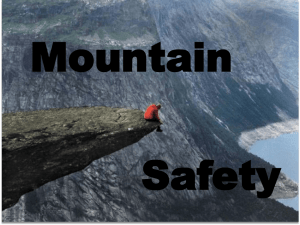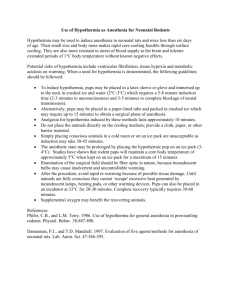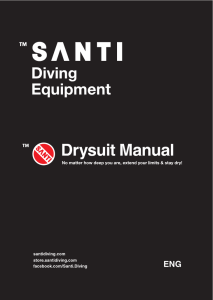HYPOTHERMIA
advertisement
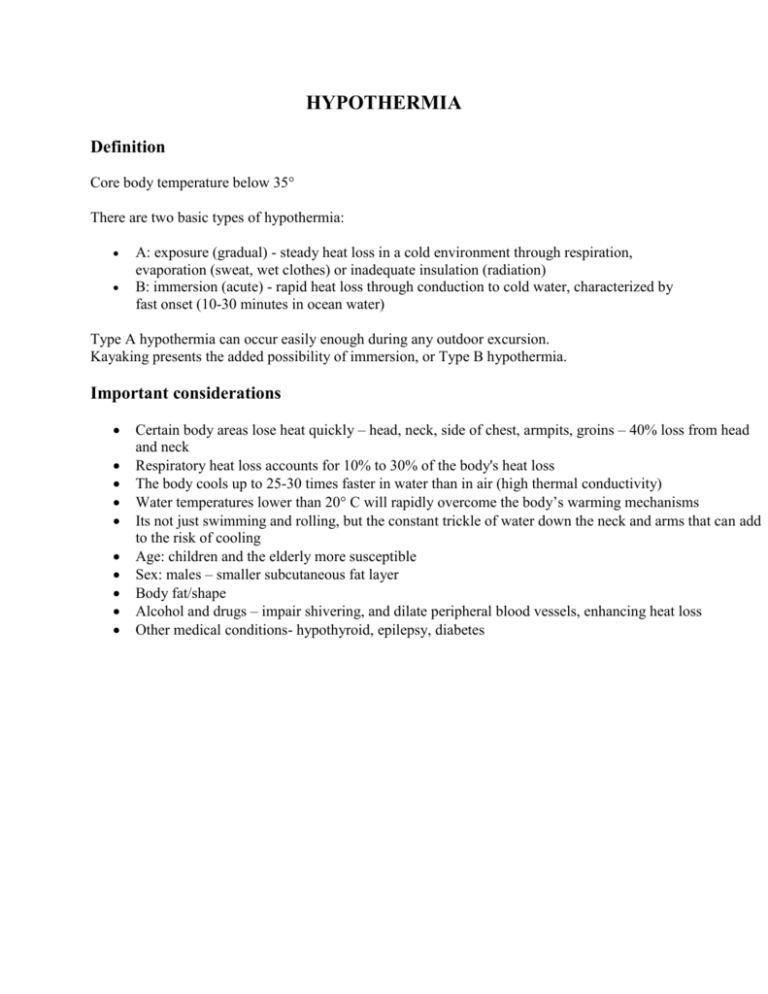
HYPOTHERMIA Definition Core body temperature below 35° There are two basic types of hypothermia: A: exposure (gradual) - steady heat loss in a cold environment through respiration, evaporation (sweat, wet clothes) or inadequate insulation (radiation) B: immersion (acute) - rapid heat loss through conduction to cold water, characterized by fast onset (10-30 minutes in ocean water) Type A hypothermia can occur easily enough during any outdoor excursion. Kayaking presents the added possibility of immersion, or Type B hypothermia. Important considerations Certain body areas lose heat quickly – head, neck, side of chest, armpits, groins – 40% loss from head and neck Respiratory heat loss accounts for 10% to 30% of the body's heat loss The body cools up to 25-30 times faster in water than in air (high thermal conductivity) Water temperatures lower than 20° C will rapidly overcome the body’s warming mechanisms Its not just swimming and rolling, but the constant trickle of water down the neck and arms that can add to the risk of cooling Age: children and the elderly more susceptible Sex: males – smaller subcutaneous fat layer Body fat/shape Alcohol and drugs – impair shivering, and dilate peripheral blood vessels, enhancing heat loss Other medical conditions- hypothyroid, epilepsy, diabetes What to look out for NEVER RELY ON A PADDLER TO RECOGNIZE OR DETECT CHANGES IN THEMSELVES. ALWAYS BE ON THE LOOK OUT FOR SYMPTOMS IN OTHERS Mild: (core temp > 35°) Shivering ( max at 35°)- usually accompanied by increased pulse and breathing rates Blood shunting - cold, white hands and feet (as the blood vessels in the skin constrict) Moderate: (core temp < 35°) Mental changes become apparent Irrational and irritable behaviour Confusion, abnormally clumsy, paddling off-course, erratic behaviour, dropping paddle Blurred vision and lack of coordination. Difficulty with self rescue Muscles start stiffening Severe: (core temp < 33°) Blue-ish lips and fingertips from poor oxygenation of the tissues near the body surface Muscular rigidity and shivering stops- a build up of acid metabolites (waste products) occurs in the muscles due to poor circulation of the extremities. Slow reflexes Impaired brain function - as the brain cools, brain cell metabolism slows Level of consciousness deteriorates – confusion, despair, disinterest, incoherence, eventual unconsciousness Pulse and respirations begin to slow as the body core cools to 30 degrees C Below 30 degrees C, signs of life are very difficult to detect - occasional breaths/gasps 4-5/minute, pulse may be undetectable, pupils will be dilated and fixed Cardiac rhythm changes at < 28°, cardiac arrest < 24° Additional effects of cold water: Cold water shock Cold water triggers a respiratory response – gasp and hyperventilation Gasping may cause water inhalation/coughing and panic Hyperventilation will enhance respiratory heat loss, and hyperventilation itself can cause dizziness and confusion, numbness and tingling, and cramping After 30-60 seconds of immersion, respiratory rates can increase to 4 times normal, it can take up to 5 minutes to get rate back to normal (assuming no panic!) Your ability to hold your breath in cold water is reduced to 1/3 normal or more (less than 15-25 seconds in water colder than 15 degrees) Cardiovascular changes: increased load on heart with increased pulse and blood pressure Slower, weaker muscles are less likely to be able to swim or tread water, or assist in self rescue How to treat it Mild hypothermia (Core temp > 35°): Person is conscious, talking clearly and sensibly, feeling cold and shivering get the person out of the water to a dry sheltered area replace wet clothing with dry layers, covering the head and neck e.g. dry clothing, blanket, insulating blanket, don’t forget socks and gloves physical activities to generate muscle heat, but avoid sweating supply hot dinks - avoid caffeine and alcohol high energy foods apply hot packs (water bottles, thermos, warm campfire rocks wrapped in hot, wet towels) to groin, head, neck and sides of the chest Persistant and sever shivering is a sign that you are on the edge of more severe hypothermia – Never ignore it Active external rewarming ( fire/bath) is generally safe only for mild hypothermia and core temp >35 Moderate-severe hypothermia (Core temp < 35°)- Needs hospital Muscular stiffening and cramping, behavioural and speech changes mark the next phase, which can herald a life threatening situation Handle the person very carefully, and gently to avoid cardiac arrest (see below) Do not get the person to exercise and restrict ALL activity ( for at least 30 minutes in milder cases) Watch closely for further deterioration Do not warm, rub or stimulate the person’s limbs - this may bring cold, stagnant blood and acidic waste metabolites from the body surface to the body core, resulting in cardiac arrest (studies have shown that active external rewarming has a higher mortality rate than active internal rewarming) Keep the person horizontal, or feet slightly higher than the head, to maintain blood flow to the brain (prevents shock: if the person has been immersed for some time, then blood pressure can fall quickly, when taken from the water) Remove wet clothing – it may be better to cut off wet clothes, as muscular activity may trigger afterdrop (see below) Insulate them from further heat loss and keep the head covered Place in a dry sleeping bag or wrap gently in blankets /insulating blanket (insulation does not prevent further cooling of the core) Warm the victim's lungs e.g. by mouth-to-mouth breathing (providing warm exhaled air, timed with their breaths) Apply hot packs to the neck, armpits, sides, chest and groin – the aim is not to rewarm, but to stabilize the core temp (and prevent ongoing temperature drop). Remember to insulate the heat source, as the hypothermic skin is very sensitive and will burn If there is going to be a prolonged delay in rescue- provide body heat (wrap together in sleeping bag or blanket) but slow external rewarming (as opposed to core warming) can bring on arrhythmias Do not give hot showers or baths to a severely hypothermic person Do not give anything orally, until the conscious state has recovered and the person can safely cough and swallow – hot drinks are NOT effective in warming severely hypothermic people ( may be tolerated in milder cases) Do not give alcohol or caffeine (includes tea!) The most effective and safest treatment for all levels of hypothermia is the addition of heat to the body core The most important phase of treatment is the prevention of post-rescue collapse during the first 30 minutes following rescue, and en-route to hospital Afterdrop– just when you thought it was safe! Temperature afterdrop - as you re-warm a severely hypothermic person, the cold blood from the limbs returns to the core, resulting in another 1-2 degrees C core temperature drop Acidosis occurs - as the acid waste products from cell metabolism in the extremities is returned to the heart, which may result in re-warming shock Both afterdrop and acidosis may precipitate cardiac arrest. Severe/profound hypothermia (core temp <33°) Check the persons airway Place in the recovery position (if still breathing but unconscious), and continue to check pulse and respirations Begin slow mouth to mouth persons own rate if very slow ( 4-5/min) If severely delayed rescue, turn the person every 2 hours to protect skin Resuscitation? Remember ABC's (Airway, Breathing, Circulation); make sure the patient has an open airway, is breathing and has a pulse. One may be tempted to start CPR on a severe case - it is very difficult in the field to distinguish between severe hypothermia and cardiac arrest Chest compressions or any other rough handling of a severely hypothermic person may convert a slow, low output heart rhythm into ventricular fibrillation, (cardiac arrest) Check for any body movement or respiratory effort, and feel for a carotid pulse (in the neck, to the side of the windpipe) for one full minute before initiating CPR If there is any pulse or respirations noted, chest compressions are NOT to be given Slower than normal rates of CPR can be given e.g. 6-12 breaths/40-60 compressions/min ( normal= 15:80-100/min) Don’t forget Remember that the person may have other possible injuries - when affected by hypothermia, you are less likely to feel and respond to pain If you come across a group in the water, consider rescuing in the following priority: children, those with slight build, those who are very quiet A person may deny they are in trouble – believe what you see, not what they say How to prevent it Before you get going Recognize the environmental conditions leading to hypothermia. Dress for the water temperature not the air temperature Clothing is designed to minimize heat transfer to the air/water Wear appropriate clothing for cold and wet conditions; paddling gloves, booties Wear a hood at all times – thin balaclavas can go under your helmet, e.g. silk ones, neoprene hoods Use polypropylene underlayers to wick water away from the skin, a wind- and waterproof covering Physical fitness, continuous exercise, high-calorie food and a hot thermos of tea or hot chocolate will prevent the onset of mild hypothermia Avoid exhaustion by knowing your limits. Try and avoid energy-depleting activities in cold conditions In wilderness settings, carry fire-starting materials and some form of improvisational shelter. Carry a mobile phone, (+/- VHF radio) and know how to call for help Always have someone carry a dry bag with spare changes of clothes and a blanket/insulating blanket Carry chemical hot packs and a thermometer in your first aid kit (to check core temp, you need an oral or rectal temp reading, and you need a low-reading thermometer – that measures down to 21 °) Ordinary household thermometers go down to only 34°C and glass ones should be voided as they could break Know your paddling partners. Learn to recognize the early warning signs of hypothermia Always use good judgment and never paddle alone In the water The best defense against hypothermia is staying dry- if you roll, or swim, get out of the water as fast as possible - get back into your boat, or at least back onto it, or make it to the side of the river and out of the water as soon as possible Be alert and aware of others, and attempt their rescue ASAP When in the water, reduce heat loss: protect the head, neck, sides of the chest and groins Keep your head out of the water and keep your hood and helmet on Best to wait quietly if help close by, even small amounts of exertion will aggravate heat loss in extreme temperatures To swim or not to swim? –relates more to sea-kayaking Swimming: always an option but leads to faster heat loss and exhaustion Cramp and hypothermia develop more quickly in cold temperatures and even if a strong swimmer, a victim usually becomes semiconscious and is likely to drown Swimming increases heat loss (increase by 35-50%) and is not recommended if you are more than one kilometer away from shore Adopt a heat conserving strategy (help or huddle) instead Use HELP (Heat Escape Lessening Position): arms folded across the chest, ankles crossed, thighs close together and knees bent "H.E.L.P." Huddle two or more persons with chests held close together if help not imminent, and boats not within easy reach. Consider your circumstances carefully before deciding to swim, is there a favorable current to assist you etc. Avoid treading water if possible as it leads to rapid heat loss: wear a PFD! Do not remove clothing or shoes, they provide insulation (a jacket can trap air and assists floating). Keep calm and make yourself visible Carry a whistle Water Temperature in Degrees C (Degrees F) 0.3 (32.5) Loss of Dexterity (with Exhaustion? or no protective Unconsciousness? clothing) Expected Time of Survival Under 2 min. Under 15 min. Drysuit with fleece layers, Under 15 to [neoprene booties]? or 45 min. mukluks?, beanie?, [neoprene gloves]? 15 to 30 min. 30 to 90 min. Drysuit with fleece layers, [neoprene booties]? or mukluks?, beanie?, [neoprene gloves]? 1 to 3 hrs. Drysuit with fleece or polypro layers, [neoprene booties]?, beanie?, gloves? 1 to 2 hrs. 1 to 6 hrs. Drysuit with polypro layers or 3mm wetsuit plus drytop, [neoprene booties]?, hat 0.3 to 4.5 (32.5 Under 3 min. to 40) 4.5 to 10 (40 to Under 5 min. 50) 10 to 15.5 (50 10 to 15 min. to 60) 30 to 60 min. Recommended Paddling Clothing* 15.5 to 21 (60 to 70) 30 to 40 min. 2 to 7 hrs. 3mm Wetsuit with light 2 to 40 hrs. paddling jacket, paddling shoes, hat 21 to 26.5 (70 to 80) 1 to 2 hrs. 2 to 12 hrs. 3 hrs. to indefinite Thin (1-1.5mm) or [shorty wetsuit]? or Hydroskin?s Over 26.5 (Over 80) 2 to 12 hrs. Indefinite Indefinite Swimsuit This table is intended as a basic guide for paddling apparel selection for various water temperatures. If water/weather conditions are rough or paddlers are inexperienced, clothing one or two levels more protective should be considered. Always wear a PFD.
